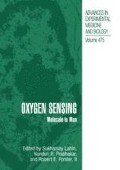Abstract
Oxygen sensing is a fundamental physiologic requirement of all living organisms and all cells within the human body. This paper presents a brief summary of recent investigations into the molecular mechanisms underlying oxygen sensing and adaptive responses to hypoxia, with particular reference to other papers in this volume.
Access this chapter
Tax calculation will be finalised at checkout
Purchases are for personal use only
Preview
Unable to display preview. Download preview PDF.
References
Chandel, N.S., Maltepe, E., Goldwasser, E., Mathieu, C.E., Simon, M.C., and Schumacker, P.T. Mitochondria! reactive oxygen species trigger hypoxia-induced transcription. Proc. Natl. Acad. Sci. USA 95;11715–11720, 1998.
Clementi, E., Brown, G.C., Foxwell, N., and Moncada, S. On the mechanism by which vascular endothelial cells regulate their oxygen consumption. Proc. Natl. Acad. Sci. USA 96;1559–1562, 1999.
Cutz, E., and Jackson, A. Neuroepithelial bodies as airway oxygen sensors. Respir. Physiol. 115:201–214, 1999.
Giulivi, C. Functional implications of nitric oxide produced by mitochondria in mitochondrial metabolism. Biochem. J. 332:673–679, 1998.
Gleadle, J.M., Ebert, B.L., and Ratcliffe, P.J. Diphenylene iodonium inhibits the induction of erythropoietin and other mammalian genes by hypoxia: implications for the mechanism of oxygen sensing. Eur. J. Biochem. 234:92–99, 1995.
Goldberg, M.A., Dunning, S.P., and Bunn, H.F. Regulation of the erythropoietin gene: evidence that the oxygen sensor is a heme protein. Science 242:1412–1415, 1988.
Iwai, K., Drake, S.K., Wehr, N.B., Weissman, A.M., LaVaute, T., Minato, N., Klausner, R.D., Levine, R.L., and Rouault, T.A. Iron-dependent oxidation, ubiquitination, and degradation of iron regulatory protein 2: implications for degradation of oxidized proteins. Proc. Natl. Acad. Sci. USA 95:4924–4928, 1998.
Kerr, R.A. Early life thrived despite earthly travails. Science 284:2111–2113, 1999.
Lopez-Barneo, J., Pardal, R., Montoro, R.J., Smani, T., Garcia-Hirschfeld, J., and Urena, J. and Urena, J. K+ and Ca2+ channel activity and cytosolic [Ca2+] in oxygen-sensing tissues. Respir. Physiol. 115:215–227, 1999.
Ma, E., Xu, T., and Haddad, G.G. Gene regulation by O2 deprivation: an anoxia-regulated novel gene in Drosophila melanogaster. Mol. Brain Res. 63:217–224, 1999.
Salceda, S., and Caro, J. Hypoxia-inducible factor la is a non-heme iron protein: implications for oxygen sensing. J. Biol. Chem. 273:18019–18022, 1998. Correction: J. Biol. Chem. 274:1180, 1999.
Semenza, G.L. Regulation of mammalian O2 homeostasis by hypoxia-inducible factor 1. Annu. Rev. Cell Devel. Biol., in press, 1999.
Taylor, B.L., and Zhulin, I.B. PAS domains: internal sensors of oxygen, redox potential, and light. Microbiol. Mol. Biol. Rev. 63:479–506, 1999.
Wingrove, J.A., and O’Farrell, P.H. Nitric oxide contributes to behavioral, cellular, and developmental responses to low oxygen in Drosophila. Cell 98:105–114, 1999.
Wood, S.M., Wiesener, M.S., Yeates, K.M., Okada, N., Pugh, C.W., Maxwell, P.H., and Ratcliffe, P.J. Selection and analysis of a mutant cell line defective in the hypoxia-inducible factor-la subunit (HIF-1a): characterization of HIF-1a-dependent and independent hypoxia-inducible gene expression. J. Biol. Chem. 273:8360–8368, 1998.
Youngson, C., Nurse, C., Yeger, H., and Cutz, E. Oxygen sensing in airway chemoreceptors. Nature 365:153–155, 1993.
Author information
Authors and Affiliations
Editor information
Editors and Affiliations
Rights and permissions
Copyright information
© 2002 Kluwer Academic Publishers
About this chapter
Cite this chapter
Semenza, G.L. (2002). Chairman’s Summary: Mechanisms of Oxygen Homeostasis, Circa 1999. In: Lahiri, S., Prabhakar, N.R., Forster, R.E. (eds) Oxygen Sensing. Advances in Experimental Medicine and Biology, vol 475. Springer, Boston, MA. https://doi.org/10.1007/0-306-46825-5_29
Download citation
DOI: https://doi.org/10.1007/0-306-46825-5_29
Publisher Name: Springer, Boston, MA
Print ISBN: 978-0-306-46367-9
Online ISBN: 978-0-306-46825-4
eBook Packages: Springer Book Archive

